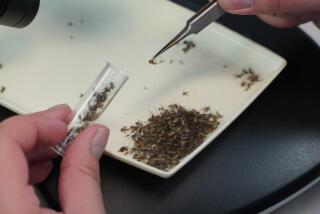Digging Up Trouble
- Share via
SANTA ANA — Orange County flood control worker Jim Dourte was patrolling his area along the Santa Ana River bike path when he abruptly braked his pickup and sprang into action.
“Here’s where I have a lot of trouble,” he said, pointing down a dirt embankment. “Look at all the squirrel holes. There’s one there, there and there! Don’t step on them, they’ll cave in.”
With expert eyes, Dourte focused on dozens of well-dug rodent holes where he had placed poisoned bait stations near Warner Avenue and Harbor Boulevard. “There are holes all over and they can go 100 feet in that direction,” he added, motioning toward the concrete-lined Santa Ana River.
Dourte and two other workers have full-time jobs eliminating varmints as part of the county’s El Nino preparations.
Herbert Nakasone, manager of the county flood program, advised the Board of Supervisors that it’s vital to control squirrels and gophers before they dig through and weaken embankments and dirt levees along the county’s 350 miles of river and flood-control channels.
If enough damage is done, levees and embankments can collapse, according to Dourte’s boss, Bill Hisey, a pest and vegetation supervisor for the county.
In 1983, during California’s last El Nino, the county was held responsible in a civil trial for the failure of an earthen levee that left two Huntington Beach mobile-home parks flooded. At issue: Instead of being lined with concrete, the levee was made of soil, which was riddled with gopher holes.
The rodents have ravenous appetites and strong teeth that enable them to chew and claw through dirt, asphalt, gravel--even wire.
But “we don’t have evidence that they can eat their way through concrete,” Dourte said.
There’s another potential problem: If the pests die or abandon their tunnel, larger animals such as foxes, skunks and ground owls can move in, enlarge the hole and cause structural failure.
It’s an ongoing battle and one the county can’t win, officials admit.
“We will never be able to get rid of all of them,” Dourte said. “We can control them by attempting to keep their levels suppressed.”
*
For suppression, the county relies on the rodents’ appetites. At bait stations where small blue plastic boxes are placed at ground level, crews place chlorophacinone, an anti-coagulant that also attacks the stomach lining.
“They have to feed a minimum of five days for the poison to work,” Hisey said, adding the county does not use traps and prefers this rodenticide because it’s safer in case it’s accidentally eaten by domestic pets.
“Dogs and other animals wouldn’t be as likely to come back and feed or use it as a permanent food source,” Hisey said. ‘
Keeping the rodent population down is crucial not only to channel protection but to public health. Hisey said rodents can carry bubonic plague and other diseases and attract fleas. County workers always warn the public not to feed squirrels that may live in their area.
“The ground squirrel has adapted very well,” Dourte said, adding that he has seen them eat seeds, citrus, strawberries--”anything they can.”
Dourte has learned to detect the whereabouts of his enemy. He looks for freshly dug dirt, or tracks. With gophers, he searches for small mounds. Cobwebs over the holes are a good sign because they indicate no activity.
“Look at the ground here,” he said, pointing with the toe of his boot. In front of him were hundreds of small mounds of dirt about two to three inches in diameter, barely higher than the surrounding surface.
“They look like little puffs of earth, right?” he said. “Well, it’s evidence that this is a new problem area.”
With his thick protective eye wear, long pants, long-sleeved shirts and gloves, Dourte attracts public attention and sometimes ire while at work.
“We’re always confronted,” Dourte said. “But I’m always honest and tell them what will happen if you don’t control this problem. Many people think we should let ground squirrels and the gophers live. But if we didn’t do any treatment, their numbers would skyrocket. They will continue to grow in numbers as long as they have food and shelter.”
More to Read
Sign up for Essential California
The most important California stories and recommendations in your inbox every morning.
You may occasionally receive promotional content from the Los Angeles Times.










